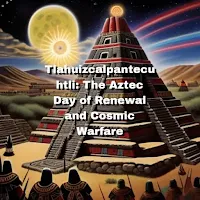Which day of the Aztec calendar was dedicated to Tlahuizcalpantecuhtli?
Which day of the Aztec calendar was dedicated to Tlahuizcalpantecuhtli?
Tlahuizcalpantecuhtli, often referred to as the Morning Star or Venus, held significant importance in the Aztec calendar and cosmology. Within the Aztec pantheon, Tlahuizcalpantecuhtli was associated with dawn, renewal, and the cycles of time. His name translates to "Lord of the Dawn" or "Lord of the Star of the Dawn" emphasizing his connection to the celestial body.
 |
| Tlahuizcalpantecuhtli |
1. Symbolism of Venus
In Aztec belief, Venus was seen as a powerful celestial entity, representing both creation and destruction. Tlahuizcalpantecuhtli was associated with the dual nature of Venus, embodying the concept of renewal through the dawn while also being linked to warfare and conflict.
2. Position in the Calendar
Tlahuizcalpantecuhtli was associated with the 9th day of the 13-day Aztec week, known as the Trecena. This day was called "Ollin" in the Aztec calendar, signifying movement and change. It was believed to be an auspicious day for transformation, as it marked the culmination of a cycle and the beginning of a new one. Tlahuizcalpantecuhtli's connection to this day suggests his role in the cycles of time and the perpetual renewal of existence.
3. Cosmic Warfare
Tlahuizcalpantecuhtli was also associated with cosmic warfare, particularly with his role as the personification of the Morning Star. In Aztec mythology, there was a belief that the Morning Star engaged in a daily battle against the forces of darkness, symbolizing the eternal struggle between light and darkness. This cosmic conflict mirrored earthly struggles, emphasizing themes of conflict and rebirth.
4. Rituals and Offerings
On the day dedicated to Tlahuizcalpantecuhtli, the Aztecs likely performed rituals and made offerings to honor him and seek his favor. These rituals may have included prayers, sacrifices, and ceremonial practices aimed at ensuring the continuation of the cosmic order and the cycle of life and death.
In summary, Tlahuizcalpantecuhtli held a prominent place in Aztec cosmology, representing the dualities of creation and destruction, light and darkness. His association with the 9th day of the Aztec week underscored his role in the cycles of time and the perpetual renewal of existence. Additionally, his connection to cosmic warfare emphasized the eternal struggle between opposing forces in both the celestial and earthly realms. Rituals dedicated to Tlahuizcalpantecuhtli likely played a crucial role in maintaining cosmic balance and ensuring the continuity of life according to Aztec beliefs.
FAQ Facts:
Q: Which day of the Aztec calendar was dedicated to Tlahuizcalpantecuhtli?
A: Tlahuizcalpantecuhtli was honored on the 9th day of the 13-day Aztec week, known as "Ollin."
Q: What does Tlahuizcalpantecuhtli represent in Aztec cosmology?
A: Tlahuizcalpantecuhtli symbolizes the Morning Star or Venus, embodying themes of dawn, renewal, and cosmic warfare.
Q: Why is Tlahuizcalpantecuhtli associated with the 9th day of the Aztec week?
A: This day, called "Ollin," signifies movement and change, reflecting Tlahuizcalpantecuhtli's role in the perpetual cycles of time and existence.
Q: What rituals were performed on the day dedicated to Tlahuizcalpantecuhtli?
A: Rituals likely included prayers, sacrifices, and ceremonial practices aimed at honoring Tlahuizcalpantecuhtli and seeking his favor for renewal and cosmic balance.